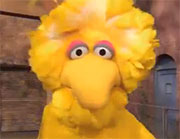
THURSDAY, Jan. 3 (HealthDay News) — Looking at how kids’ brains responded while viewing “Sesame Street” videos, researchers found that the more kids’ brains acted like those of adults, the better they performed on tests.
The findings may seem obvious. Why wouldn’t kids with adult-like brains score better on tests? But study lead author Jessica Cantlon said there’s more to the research.
“It’s a step in the direction toward understanding what typical brain development looks like and predicting what might be going wrong,” said Cantlon, an assistant professor in the department of brain and cognitive sciences at the University of Rochester, in New York.
The researchers began by scanning the brains of 27 children aged 4 to 11 and those of 20 adults as they watched 20-minute “Sesame Street” videos. The videos, showcasing stars such as Big Bird, the Count and Elmo, featured short clips focused on things such as words and numbers.
Children whose brains acted more like those of adults scored better on math and verbal tests, the researchers found.
The research is unique because it focuses on people’s responses to something from real life, Cantlon said. “We were able to show them this really complicated video where there’s a song, they’re talking about numbers and words in between music, and there are Muppets everywhere,” she said. “We were able to find a way to analyze the [brain activity] that was coming out of it.”
Timothy Brown, a developmental cognitive neuroscientist at the University of California, San Diego, who is familiar with the study findings, said they don’t say anything specifically about “Sesame Street” but instead provide insight into how kids think.
Brown said the study suggests that the kids who did the best were able to focus the most, and are probably better at that in general.
“In one sense, the study is a simple demonstration of something we probably already knew — that children who are better at [focusing] in general are better at acquiring learned academic skills, because doing so requires attention, concentration and mental effort,” Brown said. “However, the study is also novel in its use of more fluid, naturalistic, ‘real-world’ visual stimuli, which is innovative and important for advancing research on human brain development.”
Neuroscientist Daniel Ansari agreed that the research paves the way for more insight into the young brain. “We can use this to understand how children approach these inputs, what kind of information they [pay attention] to,” said Ansari, an associate professor of psychology at the University of Western Ontario, in Canada.
Cantlon, the study’s lead author, said the next step is to move to the individual level and predict how well specific children will learn things such as math. Eventually, researchers could use brain scans to determine what’s going awry in kids who are having trouble.
“It could be something wrong with their concept of numbers, or that there’s something more generally wrong — a kind of memory or attention impairment,” she said. “You could use brain activity as another tool to see what’s going wrong.”
The study was funded by the U.S. National Institutes of Health and the James S. McDonnell Foundation. It appears in the Jan. 3 issue of the journal PLoS Biology.
More information
For more about child development, visit the U.S. National Library of Medicine.

